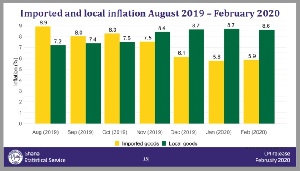For a fourth consecutive month, inflation for locally produced goods has been growing faster than inflation for imported goods, although Ghana is an import-dependent country. Inflation for imported goods as at February was 5.9 per cent, well below the 8.6 per cent inflation for locally made goods.
This is according to the latest data released by the Ghana Statistical Service (GSS).
The Consumer Price Index (CPI) measures proportionate changes in the prices of a fixed basket of goods and services that households in Ghana consume.
Inflation for imported goods declined from 8.9 per cent in August 2019 to 7.5 per cent in November 2019, when inflation for imported goods was lower than locally produced goods. The trend continued to 6.1 per cent in December 2019 and further declined to 5.8 per cent in January 2020. However, in February 2020, the rate inched upwards slightly to 5.9 per cent but remained lower than for local goods, which was at 8.6 per cent.
At the press briefing, the Deputy Government Statistician, Statistician in charge of Services, David Kombat said the cause of the decline remains unclear.
However, in the past months, the cedi has appreciated against the major international trading currencies.
The national year-on-year inflation rate was 7.8 per cent in February 2020, the same rate as last month.
Mr. Kombat said, “this continued the trend of stable inflation of about 8.0 per cent recorded over the past six months.”
Due to the relative importance in consumption, Food is still the main driver of inflation in Ghana. Compared to the same month last year, the prices of Fruits and Transport Services increased relatively more than other goods while price inflation of Electric Appliances, Cars, and Electricity decreased.
Mr. Kombat said, “Compared to January 2020, we see a shift in the inflation for the ‘Housing, Water, Electricity and Gas’ division. This division went from 7.6 per cent to 6.3 per cent, and is therefore also a less important contributor to inflation compared to previous months.”
Regional inflation
At the regional level, the Greater Accra region recorded the highest inflation of 9.7 per cent. It was followed by the Volta and Western Regions with 9.5 and 8.3 per cent respectively.
But the Upper West Region recorded the lowest inflation rate of 5 per cent.
The non-food factors that accounted for Greater Accra’s high inflation rate for February 2020, were education services at 15.8 per cent; recreation, sports and culture recorded 13.2 per cent, clothing and footwear recorded 13.1 per cent, and the least recorded is information and communication with inflation of -0.4 per cent.”
For the food inflation for Greater Accra, fish and other seafood recorded the highest with an inflation of 26 per cent, with the lowest being cereal products with inflation of -0.6 per cent.
 Home Of Ghana News Ghana News, Entertainment And More
Home Of Ghana News Ghana News, Entertainment And More





